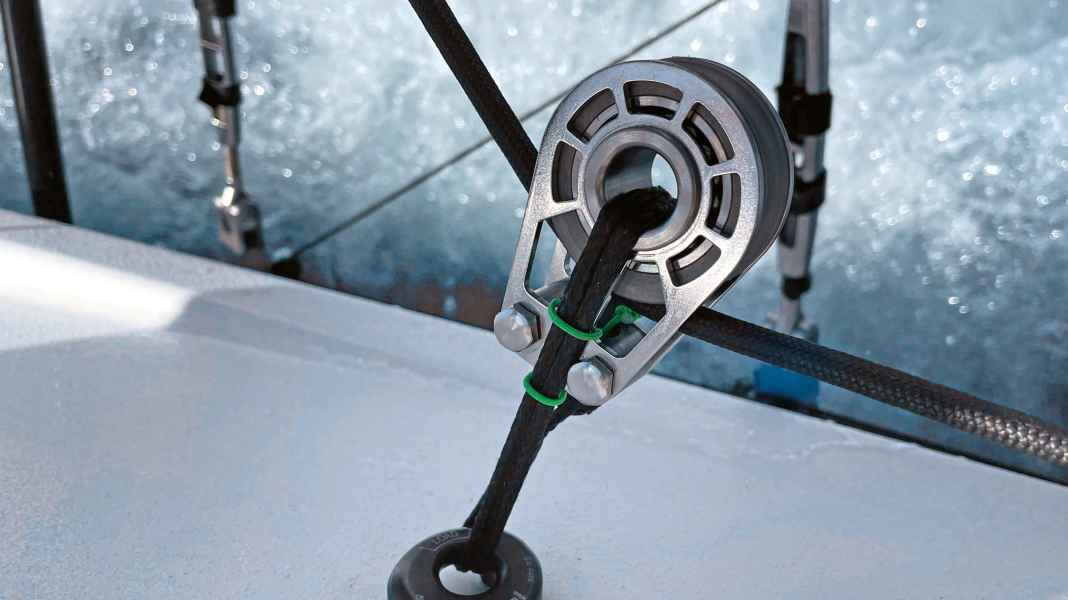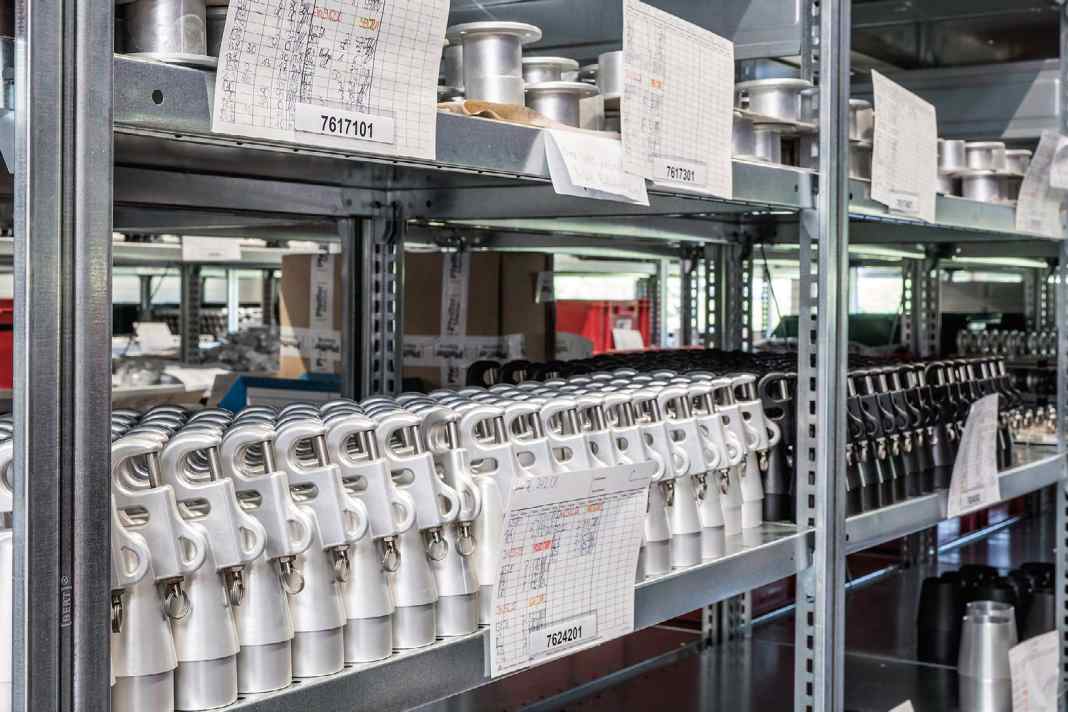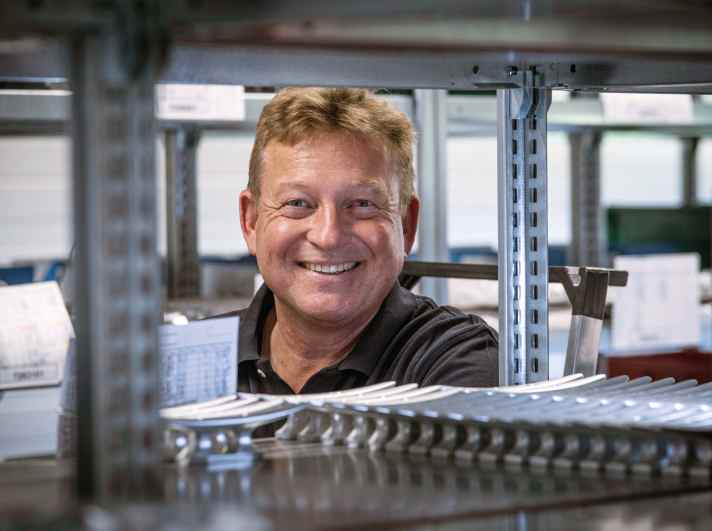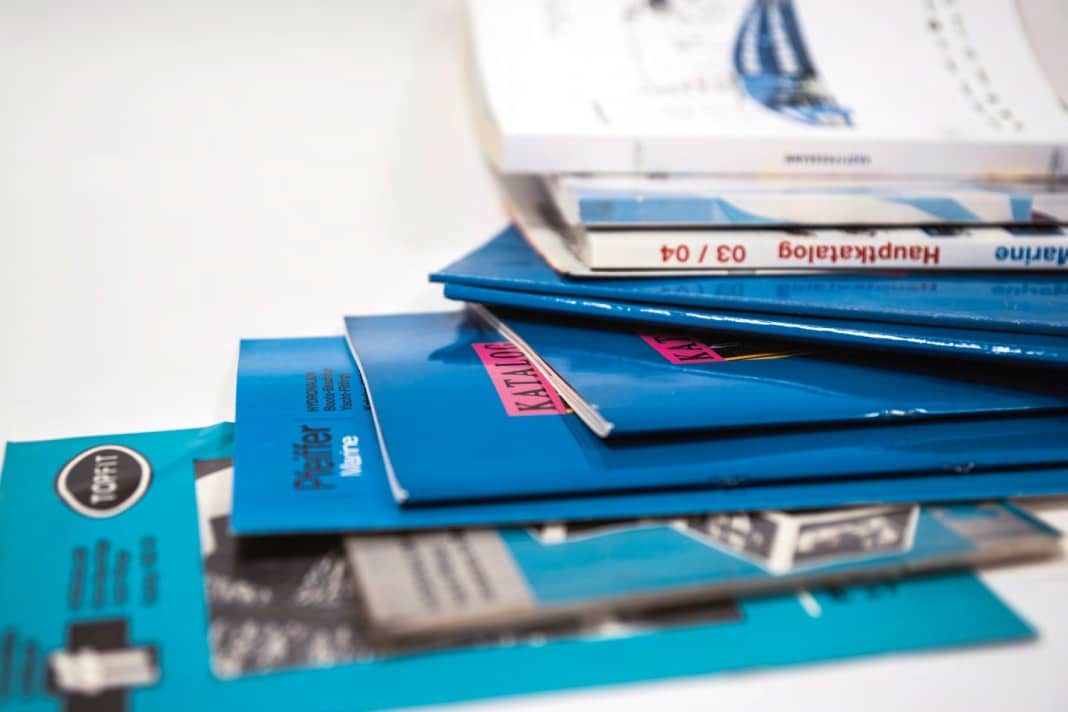
Eau de toilette and Traveller have one detail in common. At least when the Traveller fittings come from Pfeiffer Marine, a traditional company in Moos on Lake Constance. Both the perfume bottles and the bearings in the traveller sledges for the mainsheet blocks have precisely manufactured balls. The ball bearings in conventional yacht blocks are made of Delrin or Torlon, but at Pfeiffer Marine they are made of stainless steel, which also atomises Chanel's "No. 5". This speciality has been around for almost fifty years; the fittings manufacturer started out on the lake half a century ago.
Meinrad Hiller, 59 years old and with Pfeiffer Marine for 29 years, is the face and good soul of the flagship company. Initially working as sales manager for 14 years, he knows most of the customers and has been managing director ever since, together with Philipp Pfeiffer, who comes from the investor families. Walking through the new building, which was occupied four years ago, Meinrad Hiller talks about the company's history.
"In 1972, Werner Redlinger from Radolfzell had the idea of using his contact with Dutch manufacturers of aluminium boat fittings to produce them in Germany," he says, recounting the start of the company. At the time, the company operated under the name "Pfeiffer Gerätebau GmbH" and was based in Radolfzell, residing in a long building in what at the time was still a sleepy town on the shores of Untersee, just under a mile across the lake from its current location in Moos. The company was renamed in 2000 and relocated in 2018. Back then, four Pfeiffer families from Radolfzell, all water sports enthusiasts, knew Werner Redlinger; they were and are all entrepreneurs. They shared his entrepreneurial confidence and invested in production at Lake Constance.
We present the new generation of fittings with modern styling, perfect design and workmanship
This is what "Gerätebau" wrote to shipyards and suppliers on 17 September 1974. The fittings were available "at reasonable prices and made of proven, seawater-resistant hydronalium"; at the time, Pfeiffer used the term commonly used in the industry for seawater-resistant aluminium.
The first catalogue, still a narrow booklet at the time, listed aluminium lamps, filler necks and railing feet. Three years later, the first block series was launched. Right from the start, 50 stainless steel spray bottle balls rolled between 57-millimetre discs and the aluminium cheeks. Pfeiffer milled characteristic elongated holes along the edges, reminiscent of a jeans seam. The block series was discontinued, however, and today only individual blocks are available, mainly to match the jib and traveller rails.



The origin of this special ball is based on a co-operation. The four Pfeiffer families investing in the manufacture of fittings already owned "Ing. Erich Pfeiffer GmbH und Co. KG", a company for atomiser technology with 700 employees today. Precisely manufactured spheres were therefore available at favourable prices. The Delrin or Torlon balls used in all other fittings today are lighter, but weight was not yet so important for fittings, and balls and bearings were and are wear-free and easy to clean of salt crystals with fresh water. This Pfeiffer company has long since been sold and is now part of the Aptar Group with 17,000 employees and a turnover of 3.2 billion US dollars. However, the balls still come from the same plant in Radolfzell today.
Pfeiffer Marine was not part of the sale at the time. The business has scaled relatively slowly over the fifty years, with 19 people working there today. Even after the sale of some third-party products was added over the decades and the catalogue now weighs one and a half kilograms. But the processes are apparently as lean as a Lacustre yacht. Incidentally, one of the first halyard clamps was developed for this elegant model from Lake Constance - "at the time, only our multiple stoppers fitted on the slim cabin superstructure," explains Meinrad Hiller. And the new building, which was occupied in 2018, is just as smart as a Lacustre; the bilge is bone-dry and clean, so to speak. This probably also applies to turnover and financing, but there is no information on this.
Trucks weighing up to 40 tonnes can drive in at the eastern end of the long building and be unloaded dry behind closed roller shutters. They mainly supply bar material for the jib rails and travellers, specially pressed for Pfeiffer. "A tool for the extrusion press costs around 8,000 to 10,000 euros, and we have around a thousand of these tools," says Meinrad Hiller, listing some of the investments that make the range of in-house products possible, "but the tools are distributed across two plants in the region, which we have retained from the early days of deliveries for Bavaria Yachtbau." During the peak of their production, Pfeiffer received 600 six-metre-long profiles every week. The possible loss of just one pressing plant would have blocked the production at Bavaria in Giebelstadt, unthinkable. Production for the series shipyards also declined as their quantities decreased. Despite the large number of commercial products, in-house production still accounts for two thirds of turnover today.

Even in the warehouse, a specially developed circular saw can semi-automatically cut bars for shorter components. Extraction systems, carefully organised processes and an obvious knack for order, precision and efficiency make it hard to believe that extensive metal cutting also takes place at Moos.
At the moment, 3D printing is still more expensive than aluminium casting with subsequent milling
For example, the time-consuming milling of the Spibaum fittings one working area further on: step drills are used to remove unnecessary weight from the centre of the cast parts. This is also the case with the newly developed spibaum fittings. They are much more compact, and with the flat noses reminiscent of the stelae on Easter Island, they are easier to pick at the mast. For the first time, the prototypes were not produced using test castings, but with an industrial aluminium 3D printer, purchased jointly with another company in the Pfeiffer family. The result of the precision machine is visually impressive and even ready for use. "At the moment, however, printing is still more expensive than casting with subsequent milling," says Meinrad Hiller, describing the costing for the series, "but we have gained a lot of experience with this production process and already have a few ideas on how we can implement 3D printing elsewhere in the near future."
In addition to mini-series, this could include, for example, the reproduction of fittings that are no longer available. The company is familiar with the market and the refit programme for jibs and traveller rails is currently going well, explains Meinrad Hiller, "We are replacing the previous fittings one-to-one with any drill spacing."
Many owners are naturally happy to get a new rail without having to drill new holes in the deck."
Many second-hand yachts have now reached the age at which they are due for replacement. "The new rails are also far better than the old ones ever were, and the slides now also have extremely robust yet replaceable plain or ball bearings."
Meinrad Hiller is also planning a land reorganisation for the coming years. This means parting with some of the merchandise. Not, of course, from Antal from Italy and Profurl from France - "both offer extremely high-quality aluminium fittings, which is exactly our area of expertise. In any case, Antal mainly covers a length segment of ten metres or more, which we no longer serve with our products."
However, the foray into yacht electronics is over, including the Goldbrunner speedometer. Since then, new sales have been generated in non-boating areas. Ullewaeh GmbH in Lübeck, for example, sells variable suspensions for movement parks; all slides and rails come from Pfeiffer. "Fortunately, Ullewaeh handles the certification," says Meinrad Hiller, explaining the cooperation, "because that's not our area of expertise. We also do a few details differently and also label the manufacturer; understandably, the tested system parts are a little more expensive there."
Such partners became particularly important when the insolvency of major customer Dehler in 2008 and the Etap bankruptcy a year later required a new direction. Pfeiffer was on board for the Hanseatic newcomer "Varianta 18", which emerged from the "Little Red Riding Hood", but no longer for the current restart of production at Schluchsee. "We can't and don't want to take part in every ruinous price war. However, owners can still order the matching original gennaker pole from the Greifswald series from us."
Although Pfeiffer supplies exclusively via resellers, end customers are also advised; they simply have to order via the chandlers or shipyards. "We very often supply individual parts for owner yachts and also provide in-depth advice. We have our own products in stock, or we assemble them within a day from preliminary stages." Fast delivery is even more important today than it was years ago, so it pays off that many fittings are modular. Pfeiffer keeps the components in stock and produces semi-finished and finished products in idle times.



"But we have also left our specialist area of aluminium for a while," says Meinrad Hiller, pointing to the "P 1000" block. "It's made entirely from stainless steel, we developed it for an industrial customer, the ball bearings on the outside only take on the low shear forces, the main load is transferred by a roller bearing in between." Head of Sales Florian Steidle adds: "At 280 grams, the block is a little heavier, but the sailors like the styling, and this particularly robust functionality is only available in blocks that are several times more expensive with angled roller bearings, for example from the manufacturer Harken."
There are no new products explicitly for the company anniversary, but Meinrad Hiller provides a small preview. "Around 35 years ago, the block series, which was very reminiscent of the IOR era, was discontinued, and since then there have only been individual blocks, such as those for the tracks and slides.
The same Pfeiffer blocks have been in use on board our 41-year-old yacht since it was first launched, and they are still in perfect condition. It would be worth considering reviving something as solid as this.
Some innovations obviously only met with limited approval among sailors, including the "self-releasing sheet clamp", which was only briefly included in the programme in 1986. The "Surf Skiff", a rowing device for placing on the surfboard, was also hardly crowned with sales success. Other products lasted the entire fifty years: "We have a few cleats and bollards in our range, which were also included in the first or second catalogue."

